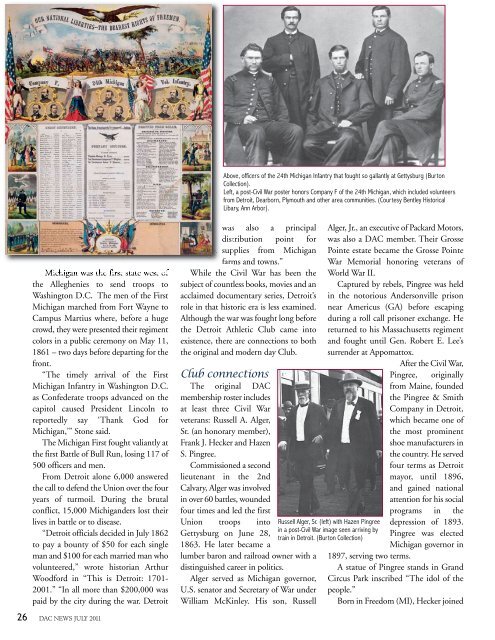Detroit and the Civil War Detroit and the Civil War Detroit and the ...
Detroit and the Civil War Detroit and the Civil War Detroit and the ...
Detroit and the Civil War Detroit and the Civil War Detroit and the ...
You also want an ePaper? Increase the reach of your titles
YUMPU automatically turns print PDFs into web optimized ePapers that Google loves.
Michigan was <strong>the</strong> first state west of<br />
<strong>the</strong> Alleghenies to send troops to<br />
Washington D.C. The men of <strong>the</strong> First<br />
Michigan marched from Fort Wayne to<br />
Campus Martius where, before a huge<br />
crowd, <strong>the</strong>y were presented <strong>the</strong>ir regiment<br />
colors in a public ceremony on May 11,<br />
1861 – two days before departing for <strong>the</strong><br />
front.<br />
“The timely arrival of <strong>the</strong> First<br />
Michigan Infantry in Washington D.C.<br />
as Confederate troops advanced on <strong>the</strong><br />
capitol caused President Lincoln to<br />
reportedly say ‘Thank God for<br />
Michigan,’” Stone said.<br />
The Michigan First fought valiantly at<br />
<strong>the</strong> first Battle of Bull Run, losing 117 of<br />
500 officers <strong>and</strong> men.<br />
From <strong>Detroit</strong> alone 6,000 answered<br />
<strong>the</strong> call to defend <strong>the</strong> Union over <strong>the</strong> four<br />
years of turmoil. During <strong>the</strong> brutal<br />
conflict, 15,000 Michig<strong>and</strong>ers lost <strong>the</strong>ir<br />
lives in battle or to disease.<br />
“<strong>Detroit</strong> officials decided in July 1862<br />
to pay a bounty of $50 for each single<br />
man <strong>and</strong> $100 for each married man who<br />
volunteered,” wrote historian Arthur<br />
Woodford in “This is <strong>Detroit</strong>: 1701-<br />
2001.” “In all more than $200,000 was<br />
paid by <strong>the</strong> city during <strong>the</strong> war. <strong>Detroit</strong><br />
26 DAC NEWS JULY 2011<br />
Above, officers of <strong>the</strong> 24th Michigan Infantry that fought so gallantly at Gettysburg (Burton<br />
Collection).<br />
Left, a post-<strong>Civil</strong> <strong>War</strong> poster honors Company F of <strong>the</strong> 24th Michigan, which included volunteers<br />
from <strong>Detroit</strong>, Dearborn, Plymouth <strong>and</strong> o<strong>the</strong>r area communities. (Courtesy Bentley Historical<br />
Libary, Ann Arbor).<br />
was also a principal<br />
distribution point for<br />
supplies from Michigan<br />
farms <strong>and</strong> towns.”<br />
While <strong>the</strong> <strong>Civil</strong> <strong>War</strong> has been <strong>the</strong><br />
subject of countless books, movies <strong>and</strong> an<br />
acclaimed documentary series, <strong>Detroit</strong>’s<br />
role in that historic era is less examined.<br />
Although <strong>the</strong> war was fought long before<br />
<strong>the</strong> <strong>Detroit</strong> Athletic Club came into<br />
existence, <strong>the</strong>re are connections to both<br />
<strong>the</strong> original <strong>and</strong> modern day Club.<br />
Club connections<br />
The original DAC<br />
membership roster includes<br />
at least three <strong>Civil</strong> <strong>War</strong><br />
veterans: Russell A. Alger,<br />
Sr. (an honorary member),<br />
Frank J. Hecker <strong>and</strong> Hazen<br />
S. Pingree.<br />
Commissioned a second<br />
lieutenant in <strong>the</strong> 2nd<br />
Calvary, Alger was involved<br />
in over 60 battles, wounded<br />
four times <strong>and</strong> led <strong>the</strong> first<br />
Union troops into<br />
Gettysburg on June 28,<br />
1863. He later became a<br />
lumber baron <strong>and</strong> railroad owner with a<br />
distinguished career in politics.<br />
Alger served as Michigan governor,<br />
U.S. senator <strong>and</strong> Secretary of <strong>War</strong> under<br />
William McKinley. His son, Russell<br />
Alger, Jr., an executive of Packard Motors,<br />
was also a DAC member. Their Grosse<br />
Pointe estate became <strong>the</strong> Grosse Pointe<br />
<strong>War</strong> Memorial honoring veterans of<br />
World <strong>War</strong> II.<br />
Captured by rebels, Pingree was held<br />
in <strong>the</strong> notorious Andersonville prison<br />
near Americus (GA) before escaping<br />
during a roll call prisoner exchange. He<br />
returned to his Massachusetts regiment<br />
<strong>and</strong> fought until Gen. Robert E. Lee’s<br />
surrender at Appomattox.<br />
After <strong>the</strong> <strong>Civil</strong> <strong>War</strong>,<br />
Pingree, originally<br />
from Maine, founded<br />
<strong>the</strong> Pingree & Smith<br />
Company in <strong>Detroit</strong>,<br />
which became one of<br />
<strong>the</strong> most prominent<br />
shoe manufacturers in<br />
<strong>the</strong> country. He served<br />
four terms as <strong>Detroit</strong><br />
mayor, until 1896,<br />
<strong>and</strong> gained national<br />
attention for his social<br />
programs in <strong>the</strong><br />
depression of 1893.<br />
Pingree was elected<br />
Michigan governor in<br />
1897, serving two terms.<br />
A statue of Pingree st<strong>and</strong>s in Gr<strong>and</strong><br />
Circus Park inscribed “The idol of <strong>the</strong><br />
people.”<br />
Born in Freedom (MI), Hecker joined<br />
Russell Alger, Sr. (left) with Hazen Pingree<br />
in a post-<strong>Civil</strong> <strong>War</strong> image seen arriving by<br />
train in <strong>Detroit</strong>. (Burton Collection)








